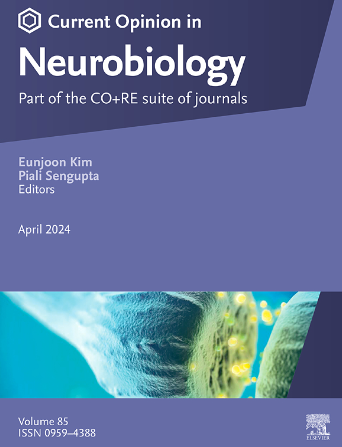哺乳动物NREM睡眠中的单胺能信号——最近的见解和下一个层次的问题
IF 5.2
2区 医学
Q1 NEUROSCIENCES
引用次数: 0
摘要
哺乳动物大脑皮层下的神经调节活动使其具有灵活的清醒行为,这是在不断变化的外部环境中生存所必需的。随着这些行为在睡眠中的抑制,这种活动,平均而言,大大减少。由于前所未有的技术进步,最近的发现挑战了长期以来的观点,即单胺能系统-去甲肾上腺素(NA),多巴胺(DA)和血清素(5-HT) -在睡眠期间基本保持不活跃。本文综述了这一领域的最新技术和科学进展,总结了大脑中单胺能信号对睡眠有重要的觉醒相关功能的证据。压力和/或神经精神状况会对单胺能信号产生负面影响,从而导致睡眠中断。此外,皮层下神经调节系统易受神经退行性病变的影响,这意味着它们在疾病早期阶段睡眠中断。我们建议未来的研究将集中在阐明跨物种神经调节动力学的时空组织、细胞机制和功能相关性,并确定在整个生命周期中维持其完整性的分子和生理过程。本文章由计算机程序翻译,如有差异,请以英文原文为准。
Monoaminergic signaling during mammalian NREM sleep - Recent insights and next-level questions
Subcortical neuromodulatory activity in the mammalian brain enables flexible wake behaviors, which are essential for survival in an ever-changing external environment. With the suppression of such behaviors in sleep, this activity is, on average, much reduced. Recent discoveries, enabled by unprecedented technical advancements, challenge the long-standing view that monoaminergic systems—noradrenaline (NA), dopamine (DA), and serotonin (5-HT)—remain largely inactive during sleep. This review highlights recent technological and scientific progress in this field, summarizing evidence that monoaminergic signaling in the brain supplements sleep with essential wake-related functions. Stress and/or neuropsychiatric conditions negatively impact on monoaminergic signaling, which can lead to sleep disruptions. Furthermore, subcortical neuromodulatory systems are vulnerable to neurodegenerative pathologies, which implies them in sleep disruptions at early stages of disease. We propose that future research will be well-invested in elucidating the spatiotemporal organization, cellular mechanisms, and functional relevance of neuromodulatory dynamics across species, and in identifying the molecular and physiological processes that sustain their integrity throughout the lifespan.
求助全文
通过发布文献求助,成功后即可免费获取论文全文。
去求助
来源期刊

Current Opinion in Neurobiology
医学-神经科学
CiteScore
11.10
自引率
1.80%
发文量
130
审稿时长
4-8 weeks
期刊介绍:
Current Opinion in Neurobiology publishes short annotated reviews by leading experts on recent developments in the field of neurobiology. These experts write short reviews describing recent discoveries in this field (in the past 2-5 years), as well as highlighting select individual papers of particular significance.
The journal is thus an important resource allowing researchers and educators to quickly gain an overview and rich understanding of complex and current issues in the field of Neurobiology. The journal takes a unique and valuable approach in focusing each special issue around a topic of scientific and/or societal interest, and then bringing together leading international experts studying that topic, embracing diverse methodologies and perspectives.
Journal Content: The journal consists of 6 issues per year, covering 8 recurring topics every other year in the following categories:
-Neurobiology of Disease-
Neurobiology of Behavior-
Cellular Neuroscience-
Systems Neuroscience-
Developmental Neuroscience-
Neurobiology of Learning and Plasticity-
Molecular Neuroscience-
Computational Neuroscience
 求助内容:
求助内容: 应助结果提醒方式:
应助结果提醒方式:


